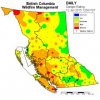http://bc.ctvnews.ca/low-snowpack-could-be-disastrous-for-salmon-scientist-says-1.2259354
fishing chilliwack river
An angler hooks a fish on the Chilliwack River on Sunday, March 1, 2015. (CTV)
CTV Vancouver
Published Sunday, March 1, 2015 4:17PM PST
Last Updated Sunday, March 1, 2015 4:23PM PST
An unusually mild winter in B.C. could spell trouble for salmon populations in streams and rivers this summer, according to local scientists.
The concerns come as snowpack levels on some B.C. mountains are a mere fraction of what they should be due to warm temperatures.
“Snowpacks on the island are around 30 per cent of average conditions and similar so in the lower Fraser and in the South Coast,” said Tobi Gardner, a hydrologist with the BC River Forecast Centre. “It’s been a warm winter, so the warm temperatures just haven’t allowed a snowpack to accumulate. And then the second factor is that when big precipitation events have hit the coast, the weather’s been warm, so that precipitation has been rain.”
Bare ski runs on Cypress Mountain are seen from CTV's Chopper 9 helicopter. Feb. 24, 2015.
One local scientist believes the reduced snowpack could put salmon populations at risk come summertime – leading to potentially disastrous results.
“It can have an impact during summer when water levels are low…and in the fall when migrating salmon return home to spawn,” said Dr. Ken Ashley of the BCIT Rivers Institute. “If its low flows and high temperatures, this could be sort of disastrous for salmonids,” he said.
For one, low water levels mean salmon are much easier prey for predators like raccoons and birds.
Also of concern is that as water temperatures warm up, diseases are able propagate more quickly.
“If a disease outbreak, if one fish was diseased, they tend to get the disease more quickly in warm water than cold water,” Ashley said. “Everything grows faster in warmer temperatures. Bacteria grow faster, algae grow faster, everything grows faster.”
The concerns come as local ski mountains grapple with bare slopes caused by the lack of snow.
Scientists say the freezing level has been unusually high this year, causing precipitation to fall on the mountains as rain.
One UBC Okanagan professor predicts that scarce snow could become the norm by 2085 if greenhouse gases continue to increase.
With a report from CTV Vancouver's Michele Brunoro
fishing chilliwack river
An angler hooks a fish on the Chilliwack River on Sunday, March 1, 2015. (CTV)
CTV Vancouver
Published Sunday, March 1, 2015 4:17PM PST
Last Updated Sunday, March 1, 2015 4:23PM PST
An unusually mild winter in B.C. could spell trouble for salmon populations in streams and rivers this summer, according to local scientists.
The concerns come as snowpack levels on some B.C. mountains are a mere fraction of what they should be due to warm temperatures.
“Snowpacks on the island are around 30 per cent of average conditions and similar so in the lower Fraser and in the South Coast,” said Tobi Gardner, a hydrologist with the BC River Forecast Centre. “It’s been a warm winter, so the warm temperatures just haven’t allowed a snowpack to accumulate. And then the second factor is that when big precipitation events have hit the coast, the weather’s been warm, so that precipitation has been rain.”
Bare ski runs on Cypress Mountain are seen from CTV's Chopper 9 helicopter. Feb. 24, 2015.
One local scientist believes the reduced snowpack could put salmon populations at risk come summertime – leading to potentially disastrous results.
“It can have an impact during summer when water levels are low…and in the fall when migrating salmon return home to spawn,” said Dr. Ken Ashley of the BCIT Rivers Institute. “If its low flows and high temperatures, this could be sort of disastrous for salmonids,” he said.
For one, low water levels mean salmon are much easier prey for predators like raccoons and birds.
Also of concern is that as water temperatures warm up, diseases are able propagate more quickly.
“If a disease outbreak, if one fish was diseased, they tend to get the disease more quickly in warm water than cold water,” Ashley said. “Everything grows faster in warmer temperatures. Bacteria grow faster, algae grow faster, everything grows faster.”
The concerns come as local ski mountains grapple with bare slopes caused by the lack of snow.
Scientists say the freezing level has been unusually high this year, causing precipitation to fall on the mountains as rain.
One UBC Okanagan professor predicts that scarce snow could become the norm by 2085 if greenhouse gases continue to increase.
With a report from CTV Vancouver's Michele Brunoro
Last edited by a moderator:






